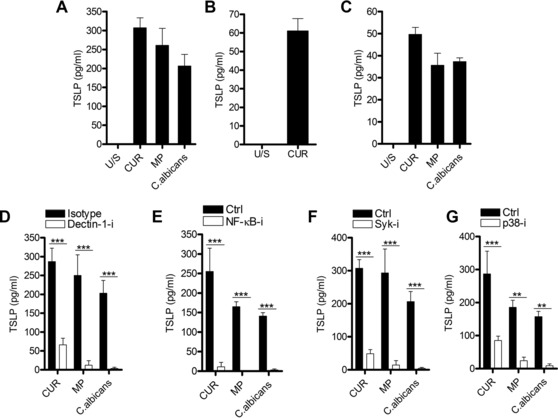Figure 1.

β‐glucans induce TSLP in human mDCs, and require dectin‐1 signaling via Syk, NF‐κB, and p38 MAPK. (A) Human mDCs were differentiated from CD14+ monocytes for 6 days using GM‐CSF and IL‐4 and were stimulated with the dectin‐1 agonists curdlan (CUR); β‐1,3 glucan MPs or heat‐killed C. albicans (MOI 2:1) for 24 h (n = 6 independent donors, presented as pooled data). (B) Human ex vivo CD1c+ DCs were isolated from PBMCs and were stimulated with CUR for 24 h (n = 2 independent donors, presented as pooled data). (C) Murine BMDCs were differentiated from cells isolated from mouse femurs for 7 days using 5% X63 conditioned media and IL‐4 and were stimulated with CUR, MP, and C. albicans for 24 h (n = 3 independent animals from a representative experiment, presented as pooled data). (D–G) Human mDCs were preincubated for 1 h with or without (D) anti‐dectin‐1 or isotype control (n = 5 independent donors, presented as pooled data), (E) Syk inhibitor (n = 6 independent donors, presented as pooled data), (F) NF‐κB inhibitor (n = 6 independent donors, presented as pooled data) or (G) p38 MAPK inhibitor (n = 5 independent donors, presented as pooled data) and were then stimulated with CUR, MP, or C. albicans for 24 h. (A–G) TSLP was measured in 24‐h cell culture supernatants by ELISA. Cumulative data are displayed as mean ± SEM. Statistical significance was calculated using (A) one‐way or (C–F) two‐way ANOVA with Bonferroni post‐tests (***p = 0.001, **p = 0.01).
